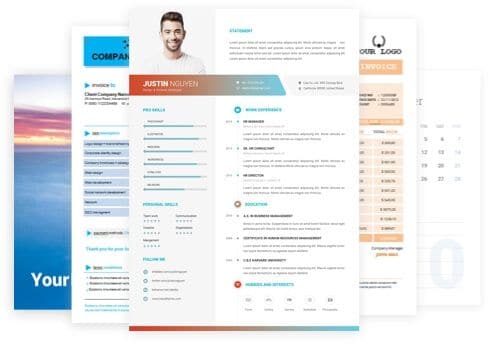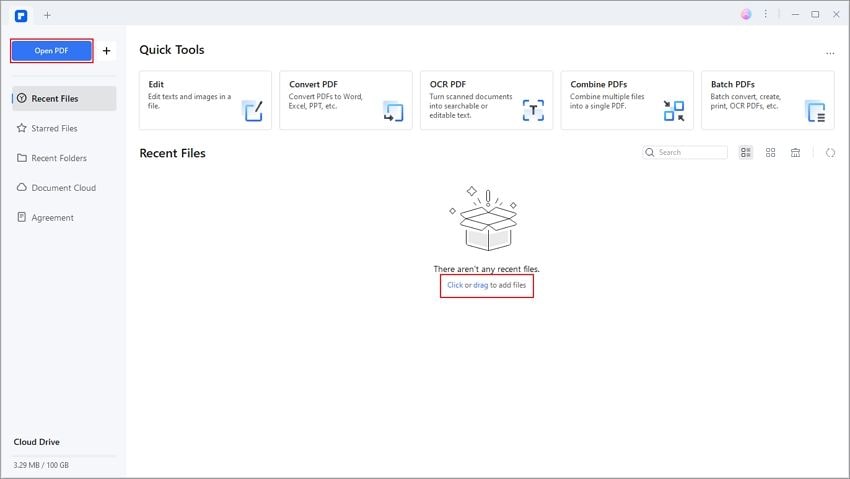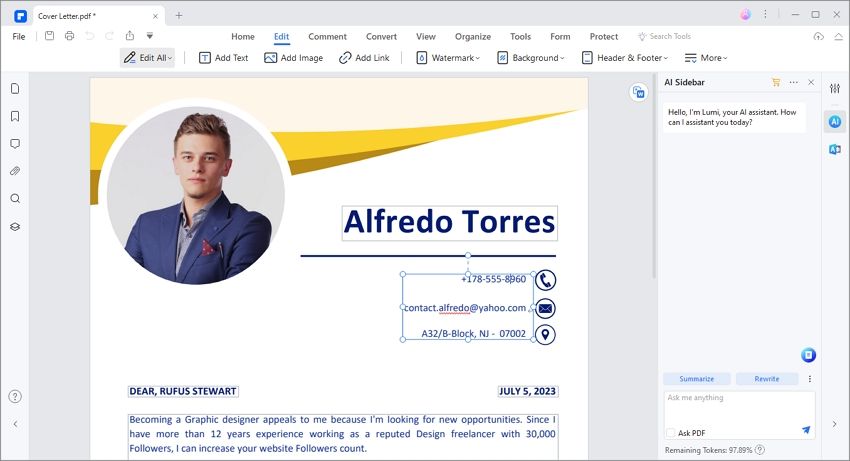If you've ever wondered how to address a cover letter, this article is perfect for you. Knowing who to address a cover letter to is a vital step in your job application. Addressing a cover letter is crucial, because it personalises your application, and makes it stand out among a crowd.
- # Who to Address a Cover Letter to
- # How to Address a Cover Letter
- # What Title to Use
- # Writing Tips and Rules to Address a Cover Letter
- # How to Address a Cover Letter in PDF
Cover Letter Template

This is a free cover letter template. Free Download and customize it according to the sample text below.
Supported formats


Who to Address a Cover Letter to
You're writing your job application, and your CV is complete and ready to go, but you're stuck at the beginning of your cover letter, not know how to address a cover letter in a professional sense. When addressing a cover letter, you'll need to do some research. It's preferred that you don't address a cover letter to unknown persons or use a cover letter with no name. These show a lack of research, and a disinterest in the position you're applying for. A cover letter should be addressed to either a manager, a recruiting representative, or any person who has signed off on the job advert.
How to Address a Cover Letter
It's vital that you know how to address a cover letter, and who to address a cover letter to. You can address a cover letter in many ways, but as long as it remains formal, which ever cover letter name technique you use should be fine. There are several ways to address a cover letter with no name attached to it:
- Dear Sir/Madame
- To Whom It May Concern
- Dear Hiring Manager
- Dear Recruiting Representative
- By using the job title of your contact (I.e. "Manager)
The easiest way to write a cover letter to an unknown person is to use one of the above. By using the job title of the contact person, you're showing that you can stay professional, even if you aren't aware of a contact's name. All of these address lines are great for cover letters where you either don't have a name to address the reader by, or don't know who the contact person is for the job. Don't feel bad if you can't find a name for your cover letter, or don't know who to address it to. Companies rarely make it easy for applicants to figure out how to address a cover letter for the job position they're advertising, and the majority of applications they get will have a cover letter with no name for a company contact.
When you use one of the above, or some variation of a nameless address, you can also bypass any title mishaps, or accidently using the name of someone who doesn't have anything to do with the job applications that the company receives. Addressing a cover letter like this is great when you don't know the gender of the person you're addressing, or you're writing a cover letter with no name, but are concerned about misgendering the recipient. In this case, writing a "dear sir or madam" cover letter is a great solution.
For a cover letter when you know the name of the person you're addressing, stick with their title and their full name, or their title and their last name. For example, "Mr. Jacob Lake" or "Mr. Lake". This is a great way to address members of management teams.
What Title to Use
For a cover letter when you know the name of the person you're addressing, or a cover letter to unknown persons, knowing how to address a cover letter can vary. If you know the name of the job contact, stick to their gender's title. "Sir" or "Mr." for men, and "Madame", "Miss.", or "Mrs." for women.
When you don't know who you're addressing, stick to gender-neutral terms, or address all genders. Terms like "Dear Sir/Madame" are used regularly, as is "To Whom It May Concern".
Never be afraid to use an ambiguous term if you don't know the gender of the person you're addressing, but where possible, do address your cover letters with the correct title of the person you're addressing. Using the wrong title could confuse the person reading it, especially if they have a common name.
Writing Tips and Rules to Address a Cover Letter
- If you don't know their name, don't skip the salutation. No matter what, you need to start a cover letter as formally as possible.
- Research. Take the time to try and locate a contact name for the company. Even if it's an area manager, addressing your cover letter to someone is preferable to addressing your cover letter ambiguously.
- Try not to use "To Whom It May Concern", there are plenty of other ways to address a cover letter, and this salutation is fairly outdated.
- Check the spelling of their name before you send off your job application. There's nothing worse than a misspelt name to start off a professional application. Take a moment to double-check.
- Stay formal, but not stuffy. If you find yourself using synonyms instead of the word you were going to use, you might be over doing it.
How to Address a Cover Letter in PDF
As PDF format becomes more and more popular, you may want to address your cover letter in PDF format. First, you need download a PDF cover letter template in this page and then edit it with Wondershare PDFelement - PDF Editor Wondershare PDFelement Wondershare PDFelement, a smart PDF editor. It will help you create, edit and customize the PDF template to make it your own.
 <
<
Step 1. Open the Cover Letter Template

Step 2. Click on "Edit" and Enter Your Text as You Like

Step 3. Complete and Save Your Cover Letter

 Create and convert cover letter in PDF.
Create and convert cover letter in PDF. Edit cover letter in PDF.
Edit cover letter in PDF. Summarize, translate, proofread contents with AI..
Summarize, translate, proofread contents with AI..






